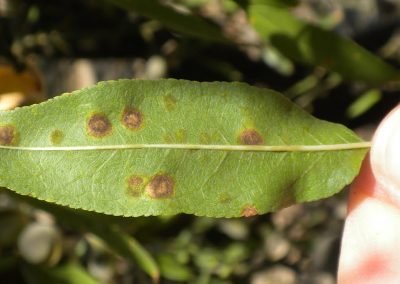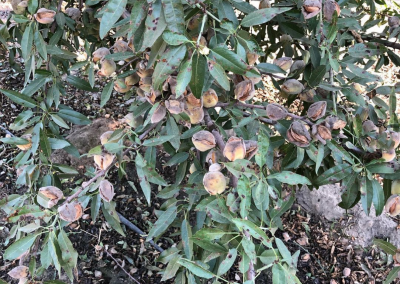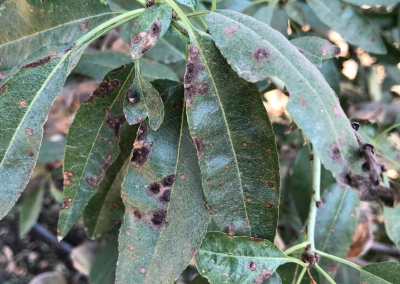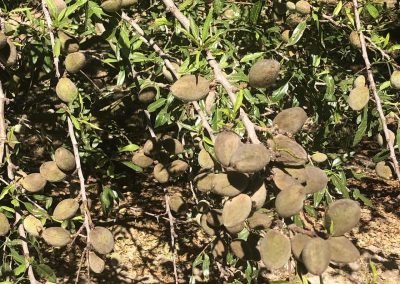Digging Deeper Case #09 Almond Alternaria & Standing Water

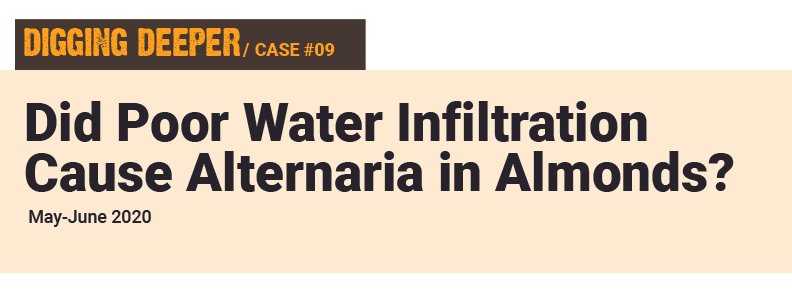
Here’s what the scene lookEd like:
SYMPTOMS:
- Necrotic spots on leaves, primarily on lower leaves and those near the outside of tree
- Moderate leaf drop
- Spots were noticed mid-May and continued to worsen for several weeks
- Areas of standing water were present throughout the field; trees nearer to standing water showed worse symptoms (photo below shows an extreme case of the standing water; tree symptoms go beyond those considered in this case)
- Digging around the wet pattern showed that water was penetrating to 8″, but not to16″ in most places
- Symptoms spanned approx. 40 acres and affected all varieties
- Neighboring almond fields (other farming companies) did not show symptoms; however, about 6 miles away another almond ranch (same farming company) showed similar symptoms.
FIELD INFO:
- Monterey, Nonpareil and Wood Colony almonds, 5th year, Kern county CA
- Drip irrigation, medium-textured soil
- No history of Alternaria
- Field spread gypsum had been banded in previous fall to address water infiltration issues (6-8 months prior)
- Irrigation water is known to have water chemistry issues that result in reduced infiltration
- Field is located in an area known to have low wind speed
Here’s what we know about Alternaria, standing water & almonds:
ALTERNARIA
- “Alternaria” or “Alternatia Leaf Spot” are common names for a disease that affects multiple crops, including almonds. In almonds the disease can be caused by various pathogens, including Alternaria alternata, Alternaria arborescens, Alternaria tenuissima
- Alternaria primarily affects the leaves and can be identified by a spot on the leaf that has a yellow/brown/dead ring around a black center that can be up to the size of a pencil eraser.
*Photo source: www.thealmonddoctor.com
- For a pathogen to take hold in a plant, three factors must be present:
- Virulent pathogen
Like many pathogens, this one can typically be found in any almond field in this area. It sits and waits for the right opportunity. [Alternaria Study] - Susceptible host
The Monterey variety is known to be particularly susceptible to this type of fungus. - Suitable environment
The Alternaria pathogen requires a warm, damp environment, or “leaf wetness” to thrive. Suitable conditions can be achieved during summer if there is limited airflow (often due to dense canopy) and sufficient humidity (often due to irrigation if there is poor infiltration).
- Virulent pathogen
[Alternaria Growth & Temperature]
[Alternaria Growth & Humidity]
STANDING WATER
- Standing water can be caused by multiple things, including soil deflocculation, poor soil aggregation, mechanical compaction (typically along drive rows from equipment) and over-irrigation.
- Deflocculation is often caused by poor water chemistry (low EC, low calcium and/or imbalanced cations)
- Poor soil aggregation is common in almond blocks because practices that benefit soil aggregation (such as cover crop) can add complications for almond farming.
Connecting the Dots:
- An in-field humidity sensor shows periods of increased humidity prior to the appearance of symptoms. These periods of increased humidity correlate to irrigation events, indicating standing water and insufficient airflow to reduce humidity.
- The canopy on these fields was dense and this region is known to have low windspeed. In-field weather station data confirmed that symptoms appeared during a time of average windspeed, so there was likely insufficient airflow to overcome the humidity caused by standing water during irrigation events.
- Based on the findings, the agronomist recommended that the grower modify the environment to be less-suitable for the pathogen; specifically, to reduce the humidity by addressing the standing water. Since the standing water was likely due to imbalanced water & soil chemistry, they recommended the following:
“Apply gypsum to the affected field. Ideally amend the irrigation water so that the gypsum is exactly where the water is, with every irrigation. This will improve soil flocculation and allow for better water infiltration.”
CASE WRAP-UP:
While poor infiltration does not directly result in a flare-up of Alternaria, it can help create the right field conditions for it. Standing water + summer temps + dense canopy creates the nice, damp environment that Alternaria is just waiting for, and you can count on a pathogen to make the most of an opportunity.
The grower did not have the ability to amend the water, but applied field spread gypsum in tight bands following irrigation lines. Several things were observed following the gypsum application:
- The soil moisture sensor data at 16″ and 24″ showed water infiltrating noticeably deeper into the soil. This improvement lasted for about 3 weeks at 16″ and 24″ and a few weeks longer at 8″.
- In-field humidity sensor data showed a noticeable decrease in humidity during irrigation events, indicating that infiltration was improved and standing water was reduced. Temperatures spiked shortly after the gypsum application, so it was good that the grower got the gypsum on as quickly as he did – otherwise symptoms likely would have spread very quickly.

FOLLOW-UP:
The agronomist returned for a follow-up visit and noted that the standing water was greatly reduced and that the spread of Alternaria symptoms had slowed significantly. However, the standing water began to return after about a month following the application.
What the field really needed was to have the water amended with gypsum.
A current water chemistry analysis of the water source showed a low EC as well as imbalanced cations. Low EC and/or imbalanced cations in irrigation water means that there is insufficient calcium (the primary flocculator in the soil) to maintain good soil structure, causing the soil structure to collapse. The field-spread application of gypsum was a good short-term solution to get calcium back in the soil to open up the pore spaces, but infiltration problems re-appeared once the untreated water overcame the effects of the gypsum.
By harvest, the standing water was significant, causing very wet drive rows. To prepare for harvest the rows had to be dried out, resulting in excessive stress on the trees.
It’s very difficult logistically to stay ahead of water chemistry issues with field-spread applications. Due to the small wet pattern of drip irrigation, the majority of the field-spread gypsum was never activated or incorporated into the soil (see image below). It is estimated that, of the 1 ton/acre application of gypsum that went on the field, only about 10-15% of it was actually activated. The majority will sit on the surface until it rains.

A nearby almond block showed an interesting contrast to this case. It had similar conditions of standing water at about the same time and was also infected with Alternaria. However, the standing water was not addressed and the conditions worsened, resulting in severe leaf damage and large-scale defoliation (see images below). So while treating with field-spread gypsum had limited effectiveness, it was still significantly better than no treatment.
During the off-season, arrangements were made for a water amending setup at this ranch. Hopefully we’ll have pictures next season that show some great infiltration!
***
Thank you Blair Baker from Irrigation Matters for letting us dig deeper with you on this case!




